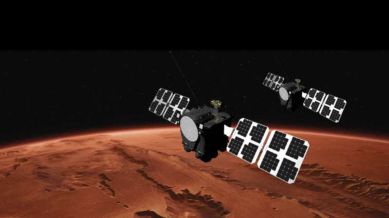NASA prepares twin probes to uncover Mars’s lost air and measure solar storm impact
The two spacecraft will start their engines in early November 2026, slingshot around Earth, and then use that momentum to travel to Mars.

NASA is preparing the first dual-satellite expedition to another planet. The Escape and Plasma Acceleration Dynamics Explorers (ESCAPADE), two identical spacecraft assigned to reach Mars, are currently slated to launch from Cape Canaveral, Florida, no earlier than Sunday (November 9).
The spacecraft will map the upper atmosphere, ionosphere, and magnetic fields of our cosmic neighbour in three dimensions once they are in the orbit of the Red Planet.
The University of California, Berkeley, which is in charge of the ESCAPADE, gave the spacecraft’s onboard satellites the colours Blue and Gold. The spacecraft will be the first to use a new trajectory to reach Mars.
The Hohmann Transfer, a route that takes seven to eleven months, has been used in previous expeditions to Earth’s nearest planetary neighbour. The trajectory required relatively limited launch windows, usually only a few weeks every 26 months, while being fuel-efficient.
ESCAPADE will first go to a Lagrange point, or a place in space where the gravitational pull of the sun and Earth is equal, rather than using the Hohmann Transfer. After that, the spacecraft will return to Earth in a 12-month orbit that resembles a kidney bean. It is planned for ESCAPADE to start engines in early November 2026, slingshot around our planet, and then use that momentum to travel to Mars.
Before reaching Mars in early 2027, satellites Blue and Gold will activate their boom arrays, data processing computers, and instrument arrays. In order to facilitate future human landings on Mars, a thorough map of the planet’s magnetic fields is required.
Mars lost its atmosphere about four billion years ago, unlike Earth. Without it, the sun’s high-energy particle radiation regularly bombards the planet. For instance, a solar storm that produced 100 days’ worth of the Milky Way’s typical background radiation was recorded in one day by NASA’s Curiosity rover last year. Even with Earth’s atmosphere, solar storms are severe enough to destroy electrical grids, but on Mars, they would be fatal to everyone without adequate shielding.
According to Robert Lillis, Chief Investigator, ESCAPADE, space weather measurements will be necessary in understanding the planet’s “system well enough to forecast solar storms whose radiation could harm astronauts on the surface of Mars or in orbit.”
Previous missions revealed that Mars still retains localised magnetic fields produced by its highly magnetised crust, even though it no longer has a global magnetic field like Earth. These are still able to push solar wind up to 932 miles from the planet’s surface, which might obstruct communications.
“Knowing how the ionosphere varies will be a really important part of understanding how to correct the distortions in radio signals that we will need to navigate on Mars and communicate with each other,” Lillis stated.
In order to provide a three-dimensional perspective of the Martian atmosphere as it experiences gusts of solar wind that fly at a speed of millions of miles per hour, Blue and Gold will go to Mars together, but they will depart on different orbits